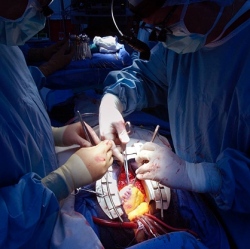
Researchers are hopeful such new advances in tissue engineering and regenerative medicine could one day make a replacement liver from a patient’s own cells, or animal muscle tissue that could be cut into steaks without ever being inside a cow.
Bioengineers can already make 2D structures out of many kinds of tissue, but one of the major roadblocks to making the jump to 3D has been keeping the cells within large structures from suffocating; organs have complicated 3D blood vessel networks that are still impossible to recreate in the laboratory.
Bioprinting
Without a vascular system — a highway for delivering nutrients and removing waste products — living cells on the inside of a 3D tissue structure quickly die. Thin tissues grown from a few layers of cells don’t have this problem, as all of the cells have direct access to nutrients and oxygen. Bioengineers have therefore explored 3D printing as a way to prototype tissues containing large volumes of living cells.
The most commonly explored techniques are layer-by-layer fabrication, or bioprinting, where single layers or droplets of cells and gel are created and then assembled together one drop at a time, somewhat like building a stack of LEGOs.
Such “additive manufacturing” methods can make complex shapes out of a variety of materials, but vasculature remains a major challenge when printing with cells. Hollow channels made in this way have structural seams running between the layers, and the pressure of fluid pumping through them can push the seams apart. More important, many potentially useful cell types, like liver cells, cannot readily survive the rigors of direct 3D bioprinting.
3D filament networks
To get around these problems, Penn researchers turned the bioprinting process inside out.
Rather than trying to print a large volume of tissue and leave hollow channels for vasculature in a layer-by-layer approach, Christopher S. Chen, the Skirkanich Professor of Innovation in the Department of Bioengineering at Penn, and colleagues focused on the vasculature first and designed free-standing 3D filament networks in the shape of a vascular system that sat inside a mold
As in lost-wax casting, a technique that has been used to make sculptures for thousands of years, the team’s approach allowed for the mold and vascular template to be removed once the cells were added and formed a solid tissue enveloping the filaments.
“Sometimes the simplest solutions come from going back to basics,” said Penn postdoctoral fellow Jordan S. Miller. “I got the first hint at this solution when I visited a Body Worlds exhibit, where you can see plastic casts of free-standing, whole organ vasculature.”
This rapid casting technique hinged on the researchers developing a material that is rigid enough to exist as a 3D network of cylindrical filaments but which can also easily dissolve in water without toxic effects on cells. They also needed to make the material compatible with a 3D printer so they could make reproducible vascular networks orders of magnitude faster, and at larger scale and higher complexity, than possible in a layer-by-layer bioprinting approach.
